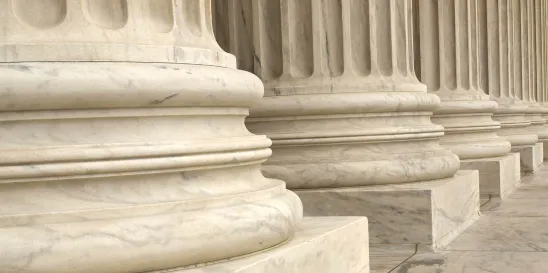The United States Supreme Court recently heard oral argument in a case arising under the whistleblower provisions of the Sarbanes-Oxley Act of 2002 (SOX), presenting the question of who must prove intent in a whistleblower retaliation case; is the whistleblower required to prove retaliatory intent in his case in chief or is the employer required to prove the lack thereof as an affirmative defense?1
Consistent with the briefing, the oral argument presented a highly technical case focused on parsing the text of SOX and weighing legislative history and analogous statutes. While the case will likely turn on these specific nuances (discussed briefly below), a ruling in either direction has the potential for far-reaching implications, including with respect to anti-retaliation statutes applicable to other industries. With the tenor of the oral argument suggesting a majority view in favor of the whistleblower’s interpretation, close attention to the scope of the Court’s ruling will be important for companies in managing whistleblower complaints and potential retaliation claims.
BACKGROUND
SOX provides a private right of action for employees to assert violations of the statute’s anti-retaliation provision, which states that publicly traded companies may not “discharge, demote, suspend, threaten, harass, or in any other manner discriminate against” an employee who reports to certain governmental authorities or supervisors conduct that the employee reasonably believes violates certain federal antifraud and securities laws.2 To prove such a claim, employees must show that the reporting “was a contributing factor in the unfavorable personnel action.” If such a showing is made, the burden then shifts to the employer to “demonstrate[]…that the employer would have taken the same unfavorable personnel action in the absence of [the protected] behavior.”3
The issue on appeal in this case largely turns on the trial court’s jury instructions, which required the whistleblower to prove: (1) engagement in an activity protected by SOX; (2) employer knowledge of such engagement; (3) adverse employment action against the whistleblower; and (4) the protected activity was a contributing factor in, and “tended to affect in any way,” the adverse employment action. No instruction was provided regarding proof of retaliatory intent.4
The jury found in favor of the whistleblower. In reversing and remanding for a new trial, the US Court of Appeals for the Second Circuit agreed with the employer that, contrary to the jury instructions, it is not enough under SOX to prove that the whistleblowing was a contributing factor to the adverse employment action and that the whistleblower must prove that the employer’s action was discriminatory (i.e., made with retaliatory intent). This ruling in favor of the employer deviates from two other circuits that held that SOX whistleblower claims do not require proof of retaliatory intent.
POSITIONS BEFORE THE SUPREME COURT
The whistleblower argues that the Second Circuit’s understanding of “contributing factor” as requiring retaliatory intent is not only unsupported by the ordinary meaning of those terms but also conflicts with how Congress incorporated a retaliatory intent requirement in other statutes, requiring a plaintiff to show that the protected activity was a “motivating factor” in the adverse action (not just a contributing one). The whistleblower further argues that Congress intended the SOX burden-shifting framework to align with the Whistleblower Protection Act of 1989 (WPA), given its near-identical language and similar goals, and WPA case law consistently disclaims a retaliatory intent requirement for the whistleblower.
In response, the employer argues that the “contributing factor” and burden-shifting elements of SOX apply to the element of causation, not the element of intent. According to the employer, the question of “whether the employer possessed discriminatory . . . intent is legally and logically distinct from the question of what factors contributed to . . . the employer’s actions,” as demonstrated by case law interpreting numerous other anti-retaliation statutes. Finally, the employer argues that the court should not extrapolate a lack of intent requirement in the WPA (which protects federal employees) and apply that to SOX (which covers the private sector).
The United States filed an amicus curiae brief in support of the whistleblower’s interpretation, asserting the interests of the Department of Labor (DOL) in adjudicating SOX whistleblower claims and the Securities and Exchange Commission in protecting those who report potential violations of the federal securities laws. The United States echoes the basis for tracking the WPA and highlights that DOL has consistently interpreted SOX as not requiring a whistleblower to prove retaliatory intent.
Based on the oral argument, several of the justices seemed hesitant to adopt the employer’s position. In particular, Justice Neil Gorsuch noted that nowhere does SOX refer to retaliation, nor did he understand how proof of retaliation did not inherently result from proving intentional discrimination. Justice Elena Kagan similarly noted, “it makes sense to put [the] question [of intent] on the employer’s side” because the employer “has the information” relating to the motivation for adverse action. Despite their skepticism, the justices nevertheless appeared inclined to rule on this case narrowly, likely because, as Justice Gorsuch noted, this case presents the Court’s first instance reviewing these SOX provisions.
POTENTIAL IMPLICATIONS
The potential implications of this case go beyond SOX and the securities and financial services industries.
First, the ruling may affect the behavior of whistleblowers. A ruling that requires whistleblowers to prove retaliatory intent could chill an employee’s decision to report concerns internally and lead to direct reports to regulators. Whistleblowers may also turn to other statutes, such as state whistleblower protection laws, which may offer a lower burden of proof. In contrast, a ruling that requires employers to prove that they did not have retaliatory intent could incentivize whistleblower reports and will reinforce the importance of detailed recordkeeping of employment decisions.
Second, a decision either way will likely shape the application of other whistleblower statutes that mirror SOX. For example, an amicus brief lists 15 other whistleblower protection statutes with the same burden-shifting language as SOX, covering “industries such as aviation, consumer products, food, healthcare, nuclear energy, pipelines, and surface transportation.”5 Litigation under any of these statutes can be expected to draw from the Court’s ruling in this case.
A decision is expected in Spring 2024. We will continue to monitor for future updates.
1 Murray v. UBS Securities, LLC, Case No. 22-660, Question Presented https://www.supremecourt.gov/docket/docketfiles/html/qp/22-00660qp.pdf
2 18 U.S.C. §§ 1514A(a), (b).
3 49 U.S.C. § 42121(b)(2)(B)(iv).
4 Halliburton, Inc. v. Admin. Rev. Bd., 771 F.3d 254 (5th Cir. 2014); Coppinger-Martin v. Solis, 627 F.3d 745 (9th Cir. 2010).
5 Murray, No. 22-660, Br. of Amicus Curiae U.S. Senator Charles E. Grassley, U.S. Senator Ron Wyden, and The Government Accountability Project in Support of Petitioner, at 16 and Appx. A, https://www.supremecourt.gov/DocketPDF/22/22-660/255093/20230406145600797_22-660%20Amicus%20Brief.pdf.






 />i
/>i
